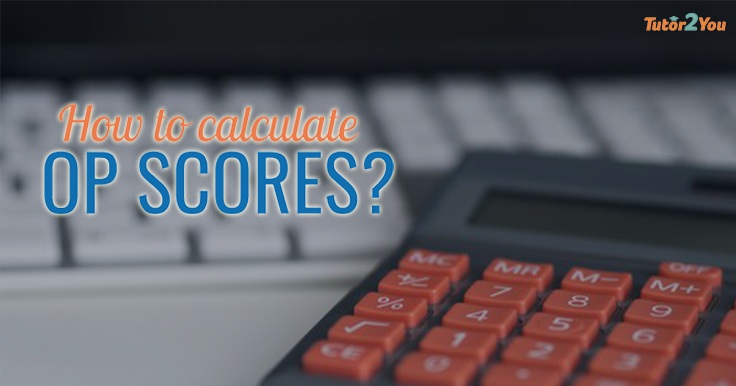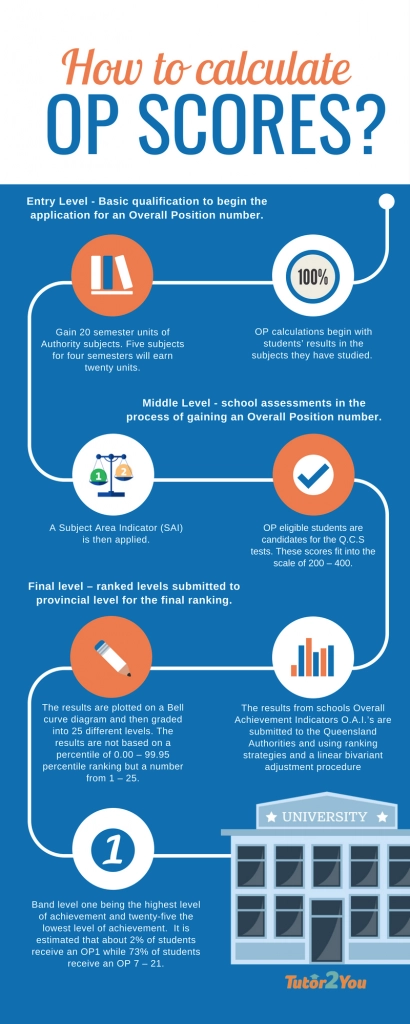
Overall Position – How to calculate OP Score?
Although the OP or Overall Position will be replaced in Queensland Schools next year making way for the ATAR (Australian Tertiary Admission Rank). Those parents who have children in year 12 are probably still wondering, how the OP score is being calculated.
The best way to understand how the Overall Position is being calculated is to be informed about the purpose it serves and how children fit into the system. What must they achieve to receive a successful Overall Position rating?

Overall Position is not a specific exam that can be sat by students with a series of questions to answer and a score to achieve.
- Firstly, the OP score is only open to students who qualify for this rating.
- Secondly the overall position scores and grading depend on the scores and ratings of other students.
Although you are sitting exams measuring your performance at school the outcome is a score that is measured in comparison to others of your academic year.
The Overall Position is measured through gradings and comparisons within the school groups and then the whole of the state. Knowing the structure of the assessment helps to understand how the performance rating is achieved.
- The process begins at an entry level to become eligible for the OP status and this is monitored by the schools.
- The next phase is the middle phase, an assessment of various subjects approved by the education department.
- The final phase moves into schools all around Queensland and the ratings are calculated among all the schools.
The purpose is to achieve the Overall Position required for entrance to tertiary education or university. The OP is recorded as a number between 1 – 25 and all students who applied will slot into this system of ranking levels in comparison with other students in year twelve.
Entry level - Basic qualification to begin the application for an Overall Position number
- Complete year 12 at school up to, and including, the last day of the school year.
- Gain 20 semester units of Authority subjects. A unit is earned after each semester in each subject. This means sitting five subjects for four semesters will earn twenty units. Authority subjects are the subjects in the curriculum, selected by the Queensland Curriculum and assessment authority known as the Q.C.A.A.
Middle level - school assessments in the process of gaining an Overall Position number
- A finer grading of students is provided by the S.A.I.’s Subject Achievement Indicators. These achievement indicators show student achievements, compared to other students, in the school system on a scale of 200 – 400 at school level in the school the student attends. The range is devised purely to compare the students in the school and does not indicate their actual scores only their position within the range of 200 – 400 points with 400 being the highest.
- There is a Q.C.S, Queensland Core Skills assessment to measure general knowledge, some writing and language skills, and a year 10 level of maths. Only OP eligible students are candidates for the Q.C.S tests. The first level of scaled measurements is applied to each student at school level and an O.I.A an overall achievement level calculated. The scores are worked out for each students S.A.I subject achieved level for their best five authority subjects. These subjects have been developed and approved by the Queensland Curriculum Assessment Authority. These scores fit into the scale of 200 – 400.
Final level – ranked levels submitted to provincial level for the final ranking
- The results from schools Overall Achievement Indicators O.A.I.’s are submitted to the Queensland Authorities and using ranking strategies and a linear bivariant adjustment procedure, the results are plotted on a Bell curve diagram and then graded into twenty-five different levels. The results are not based on a percentile of 0.00 – 99.95 percentile ranking but a number from 1 – 25. The Bell curve is designed to set the number of highest ranking students and lowest ranking students as less than the majority of students that fall into the middle or average range.
- When all the students have been ranked and scaled they are assigned to one of the twenty-five OP bands. Band level one being the highest level of achievement and twenty-five the lowest level of achievement. It is estimated that about 2% of students receive an OP1 while 73% of students receive an OP 7 – 21. Entry to university is based on the OP ranking.
Key Takeaways
- The system is complex because the results do not filter directly from one exam to another.
- Overall position scores are based on different levels of grading and ultimately the result is a series of ranking procedures and finely tuned calculations to fit students into different grading.
- The overall outcome ranks students for their eligibility to study at University.
- Although the system is open about its results there are no defined scores or percentages to refer to and students often feel disappointed in their results.
- The final result and calculation will depend on how well the other students do compare to individuals in school and then ranked in all the schools in Queensland.
In the final analysis, students can only do their personal best. Individual achievement and conscientious work will count throughout the students’ school career. Individuals will be ranked in year twelve and represented on the grading system of 1 – 25 in their final year of schooling, prior to application for tertiary education.
Read more: Understanding How ATAR Works and How to Calculate it
Get one-on-one support
If your child could use help with a specific subject or you would like one of our certified tutors to work through to ensure a productive and successful school term, call and speak to one of our consultants today on 1300 4200 79 or click here and fill in the form and your regional manager will be in touch.


